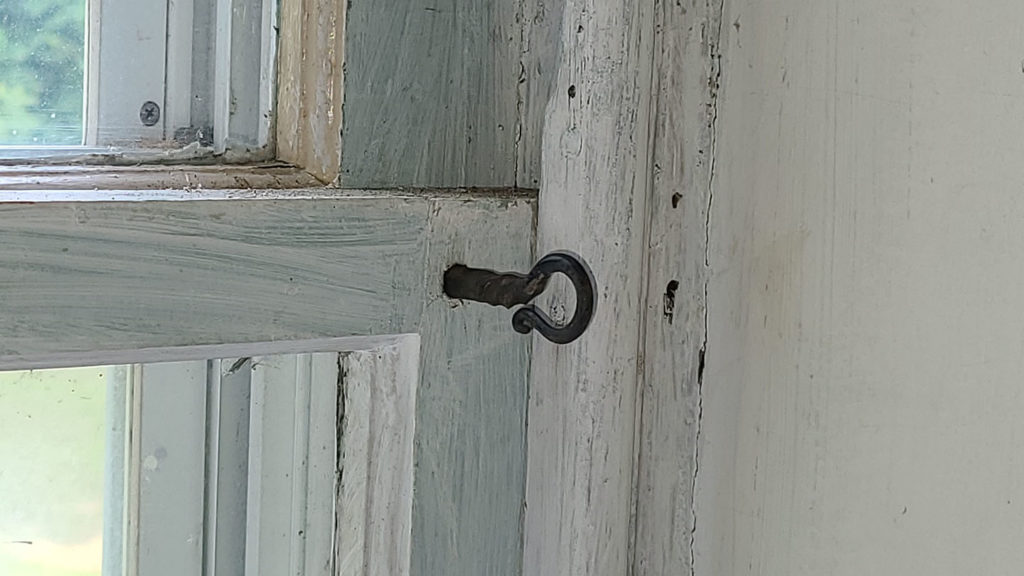LOCKED

Answer
For those that read this far, you may be thinking the item is some form of key because of its general shape. That would be a good analysis and, in a way, it does form part of a locking system. Before we reveal the item’s function, we will share that the item was spotted in use at multiple locations within the fieldstone home we visited. Upon seeing it, the item’s functionality became obvious. What was unexpected is that upon seeing the object, it answered a question that we’d had from earlier decades. For those with growing suspense anxiety, the following photograph comes from the farmhouse at Oversee Farm where quite a number of colonial-period window sash pins were in use!
The purpose of a window sash pin was to lock together upper and lower window sashes in their tracks so that either window could not be opened from the outside to gain entry into a residence. A simple rocking motion, clockwise and counter-clockwise, eases the pin into or out of the hole drilled though the inside sash frame and to a depth in the outside sash frame of about three-quarters the thickness of the outside sash frame. These pins were often affixed to the widow with a short leather strap (missing in the Oversee Farm window installations) so they’d not get misplaced when removed.
The first sash windows that slid in tracks came into use in the early 1600s in Europe. These early sash windows slid horizontally instead of vertically as commonly encountered today. It wasn’t until the mid-1600s that vertical sliding window sashes were developed in France. Towards the mid-1700s locking hardware similar to what we still use today, made of cast iron or brass, were devised that relied on levers and rotating components for locking window sashes together to prevent entry. Hand forged, wrought-iron pins made for a simple, inexpensive sash lock in the colonial times of William Penn when metals such as copper and tin were in limited supply.

The window sashes in the oldest sections of the Oversee Farm farmhouse are drilled for sash pins and those pins are still in use for a number of the windows. While County deed records note the property changed owners in 1820, the farmhouse and barn could date to the late 1700s. The wooden peg construction of the roof beams of the house and barn, coupled with window, floor, and fireplace molding details, and the finding of the sash pins, make us wonder if the Oversee farmhouse and barn weren’t built about the same time as the Garrett house on Benge Road which has been dated to the mid-1700s. Additionally the fieldstone barn displays marriage markings nearly identical to those documented in the Phillips Barn (constructed 1760s) off Old Wilmington Road as dated by the Historic American Buildings Survey.
Perhaps as part of the State’s future plans for Oversee Farm, historical research by professionals can trace back previous owners and identify construction techniques used in the farmhouse and barn to better define the earliest history of the structures on the property. The fact that the property includes a Spring & Root Cellar with what is believed to be a summer kitchen and a separate stable and carriage house, suggests wealthy owners of the property originally.
We mentioned earlier that seeing the sash lock pin in place suddenly answered a question from decades ago. In Scott’s history blog an article discusses the history of the Ward-Dudkewitz home once located in Milltown (intersection of Limestone, Milltown, and McKennan’s Church Roads). That home dated from the early 1700s and was where Washington held a meeting of his officers according to legend. The home and surrounding farmland served as my grandparent’s home where my mother grew up starting at age 13 after they moved from Richardson Park There were holes in the window sashes of that home but evidently no pins so the hole’s use remained elusive to a young teenager Upon seeing the Oversee Farm farmhouse sash pin photos, my mother realized 83 years later, what those holes were for in the window sashes of her parent’s home!
